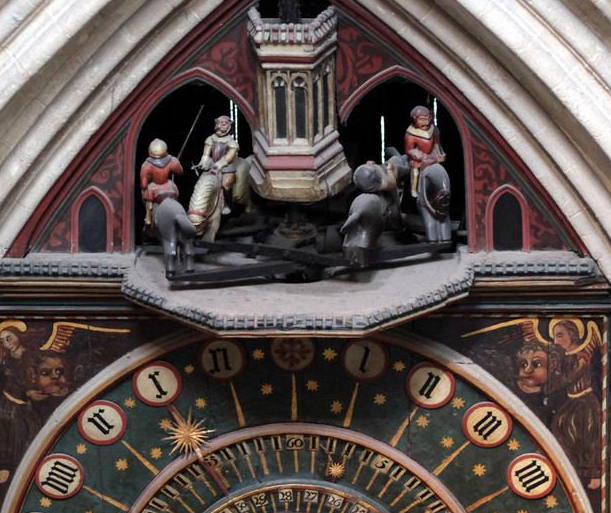Losing A Joust (every day since 1390!)
The Jousting Knights, Wells Cathedral Clock
A very happy new year to you all. As I sit here typing away I can hear the steady tick of my clock counting off the hours and minutes of the new year.
My dad was a carpenter / joiner and when he retired in the late 1980s he decided to make the cases for a series of grandfather clocks. Over the next few years, he made several clocks for various members of the family, including me.
The oak Dad used for the cases had come from my grandmother’s wardrobe! She lived to be 96 and I am sure she had inherited it, perhaps from her own parents, so it was probably Victorian.
Anyway, my vague memories of the famous wardrobe are of a hideous thing the size of a small tank. (They had to literally remove the window of my Grandmother’s bedroom to get it out. How it had got in there in the first place was a mystery). Hideous though it undoubtedly was, it had been made with some fabulous pieces of oak.
All of which brings me, in a round about way, to medieval clocks… Time in the modern world is a very different concept than it was to our medieval ancestors. That’s not to say time wasn’t important to them, particularly in the medieval town and city, the day could be closely regulated. The canonical hours would be sounded out by the church bells and things like a curfew bell that signalled the end of the working day were common.
During the 14th century, when my books are set, things slowly started to change regarding telling the time. Before mechanical clocks, the hours of daylight could be divided up with some measure of accuracy but during the night-time, particularly during the winter it would be very difficult to estimate how long you had until dawn.
It’s generally accepted that the first mechanical clocks, powered by water, originated in China probably in the 11th century. Weight-driven clocks were beginning to be developed in the first half of the 14th century.
Early clocks were nothing like their later descendants. They did not have hands or a clock face. As many were installed in church buildings they perhaps gave an indication that a bell was to be rung or later actually rang the bell itself. The clock would often be housed in a tower and encased in a metal frame. In England, during the early 14th century, there is some evidence for primitive clocks existing at the cathedrals / abbey in Lincoln, Norwich and Saint Albans although they may have had more to do with astronomical prediction than telling the time. By the 1350s mechanical clocks had been installed in the palaces of Edward III. However actual accurate time keeping by these devices was not a priority, clocks could lose or gain many minutes over a single day.
At this period there was not even an agreement of what precise length an hour should be. Most people accepted that in the winter there would be twelve short hours of daylight, and in the summer twelve long hours of daylight. It was only gradually that the length of an hour came to be more or less agreed upon and regulated for the whole 24 hour period. As mechanical clocks became more widespread, they certainly helped to make this a more acceptable way of dividing up the day.
Wells is a cathedral city in the southwest of England. It’s a place full of history spanning hundreds of years. The magnificent cathedral has a clock dating from the 14th century. (It also happens to be one of my favourite cathedrals, my fictional city of Draychester bears an uncanny resemblance to Wells…)
The original clock mechanism at Wells is dated between 1386 and 1392 and may be based on a slightly earlier clock that still exists at Salisbury Cathedral. The Well’s clock is an astronomical clock, as well as showing the time on a 24-hour dial, it reflects the motion of the sun and the moon.
The original dial (the oldest surviving clock face in the world) is located inside the cathedral with a later dial driven from the same mechanism located on the outside of the building.
I’ve stood and looked up at these dials with wonder. It’s like looking into the face of history. It makes the hairs on the back of my neck stand up just thinking about all the other people over the ages who have stood in this spot and done the same.
Inside the catherdral, driven by the mechanism of the clock, is a figure called Jack Blandifers. He sits up and above the clock face and to the right. Every quarter hour he hits a bell with a hammer held in his right hand and two bells hung beneath him with his heels.

If you ever get the chance, go and visit Wells and its famous cathedral. It’s a beautiful place with a fabulous history.
For videos of the clock, Jack Blandifers and the Jousting Knights see the links below:-
https://www.youtube.com/watch?v=NjpuBiuMvFg